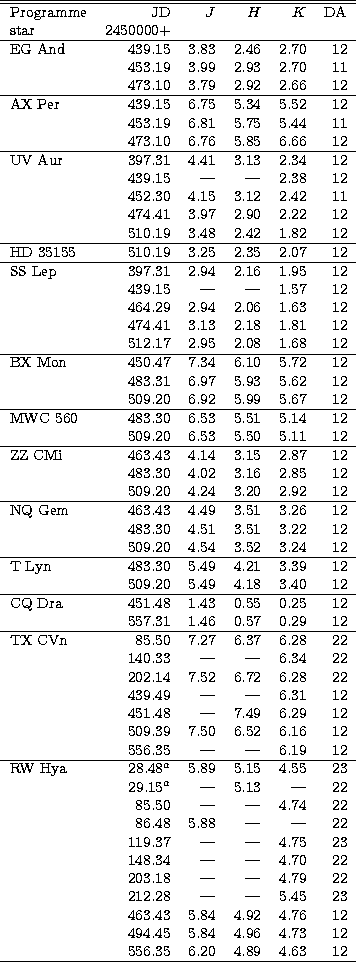All Northern and accessible Southern symbiotics
brighter than ![]() 8 and not fainter than 13 in V were chosen from the
list of
Allen (1984)
and
Kenyon (1986)
as potential targets for
observations. We reserved those in very crowded fields for observations at a
later stage even though they fulfilled the above criteria. A few suspect or
possible symbiotics (such as SS Lep) and those which were regular targets of
AAVSO and VSNET observers (e.g.: NQ Gem, T Lyn) were also selected to
be observed. Observations were scheduled at regular intervals in order to get good
phase coverage, but bad weather often precluded a more complete set of data.
8 and not fainter than 13 in V were chosen from the
list of
Allen (1984)
and
Kenyon (1986)
as potential targets for
observations. We reserved those in very crowded fields for observations at a
later stage even though they fulfilled the above criteria. A few suspect or
possible symbiotics (such as SS Lep) and those which were regular targets of
AAVSO and VSNET observers (e.g.: NQ Gem, T Lyn) were also selected to
be observed. Observations were scheduled at regular intervals in order to get good
phase coverage, but bad weather often precluded a more complete set of data.
The observations were carried out using a
LN2-cooled InSb photometer at the Cassegrain focus of the 1.2 m telescope at
PRL's Mt.Abu Infrared Observatory (72![]() 46
46![]() 45
45![]() E,
24
E,
24![]() 39
39![]() 10
10![]() N; 1680 m) during 1995-97. A 2 mm
aperture, corresponding to 26
N; 1680 m) during 1995-97. A 2 mm
aperture, corresponding to 26![]() on the sky, was generally used, the
chopper throw was
on the sky, was generally used, the
chopper throw was ![]() 30
30![]() and the chopping frequency was kept at 15
Hz for dewar 2 and 8 Hz for dewar 1. Apertures of 1 and 3
mm were used on certain occasions and the chopper throw was
correspondingly adjusted. The details of our experimental system are given in
Ashok et al. (1994).
Two different dewars - Dewar 1 (CVF) and Dewar
2 (New) - were used for obtaining the data. The filter responses of these two
systems at the operating temperature of 77 K are given in Fig. 1.
Our experience with both the dewars shows that they are essentially identical.
Hence, all the measurements are referred to in the same system. The PRL
filters, particularly K and H, are quite close to the new ESO filters;
hence photometric standard stars were selected from
Bouchet et al. (1991)
and their magnitudes in our system were adopted to be the
same as their ESO magnitudes.
This procedure is necessitated by the fact that we
are still in the process of properly calibrating our own photometric system.
All the programme stars had their own nearby "prime" comparison star from the
above list with respect to which the star magnitude was calculated. On days
where other standards were observed, intercalibration among them was done.
These observations are accurate to
and the chopping frequency was kept at 15
Hz for dewar 2 and 8 Hz for dewar 1. Apertures of 1 and 3
mm were used on certain occasions and the chopper throw was
correspondingly adjusted. The details of our experimental system are given in
Ashok et al. (1994).
Two different dewars - Dewar 1 (CVF) and Dewar
2 (New) - were used for obtaining the data. The filter responses of these two
systems at the operating temperature of 77 K are given in Fig. 1.
Our experience with both the dewars shows that they are essentially identical.
Hence, all the measurements are referred to in the same system. The PRL
filters, particularly K and H, are quite close to the new ESO filters;
hence photometric standard stars were selected from
Bouchet et al. (1991)
and their magnitudes in our system were adopted to be the
same as their ESO magnitudes.
This procedure is necessitated by the fact that we
are still in the process of properly calibrating our own photometric system.
All the programme stars had their own nearby "prime" comparison star from the
above list with respect to which the star magnitude was calculated. On days
where other standards were observed, intercalibration among them was done.
These observations are accurate to ![]() mag.
mag.
 |
Figure 1: Filter responses of the two dewars used for observations. They are traced from manufacturer's curves for the operating temperature of 77 K |
The data obtained during the course of this survey
is presented in Table 1. It lists data for a total of 30 known or suspected
symbiotics and related objects. Most of them are S-type symbiotics. The
programme objects appear in order of increasing RA. Remarks are noted in the
last column, where the first digit denotes the dewar used and the second one
refers to the aperture in mm.
 |
Copyright The European Southern Observatory (ESO)